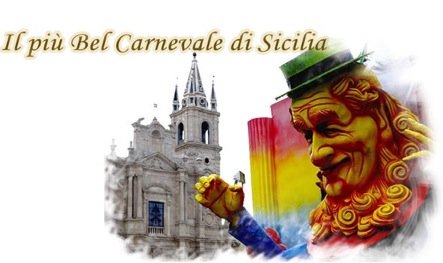An ancient celebration of heritage, fun, craftsmanship and artistic beauty
It sounds weird that a small town could offer hospitality to the most beautiful Carnival in Sicily and most important in Italy. Actually that’s so! Every year in February, a crowd of visitors coming from throughout Italy and abroad cheerfully flow in the main ways of the most ancient and coastal small town in the nord-east of the province of Catania: Acireale. The heart of the carnival in Acireale is the parade of the allegorical floats designed and created by local artisans, to whom one acknowledges the mastery in hand working the paper-mâché and in creating an unmistakable satire. Generally the masks used and seen on the floats appear as caricatures of famous people, which include known politicians, actors, musicians and artists, sports stars and other celebrities. These masks resemble the people who control the Italian political and economical environment, they are designed so they would be seen as comical and ridiculous in the eyes of the general public.
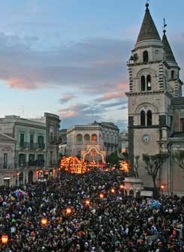 What makes it inimitable, this carnival is also the parade in the evening. Indeed, in that moment the lighted decorations at the top of the roads, the flashing lights of the coloured allegorical floats which proceed from the main square, where is located the main church, towards the back of the town, contribute to lighten an enchanting and unforgettable scenery of monumental baroque buildings of seventeenth and eighteenth century. It seems as if all these things together would want to thank all of those who are participating in the show.
What makes it inimitable, this carnival is also the parade in the evening. Indeed, in that moment the lighted decorations at the top of the roads, the flashing lights of the coloured allegorical floats which proceed from the main square, where is located the main church, towards the back of the town, contribute to lighten an enchanting and unforgettable scenery of monumental baroque buildings of seventeenth and eighteenth century. It seems as if all these things together would want to thank all of those who are participating in the show.
The floats today not only have vivid colors and shapes but also use an advanced system of lighting and movement that bring more life to the floats and the fest, too. The Acireale Carnival stays true to its origins, with the masks, the floats, and the feeling of fun and partying. Unlike older times when people used to throw eggs or vegetables at each other, today people throw confetti. The roads turn into a long carpet of confetti and usually some of them are hiding even in our clothes, hair, shoes till the next day, since they are so small that it becomes a hard work to remove them utterly.
In the evening, this flourishing baroque small town becomes a fairyland, it’s like a long walking of princesses, cowboys, Disney characters, etc. Often it happens the floats are preceded by folk groups, majorettes and dancing masked revellers coming from other countries out of Italy, who love to share the joy of a carnival that isn’t only Sicilian. Several stalls on the sidewalks sell masks, confetti, foam spraying which has also become a sort of “sport”, different kinds of funny jokes, and yet there are some others selling a choice assortment of traditional nougat. There is a sentence often recalled during the carnival time and that is ” A carnevale ogni scherzo vale” which means something like “It’s a joke! It is not worth to be offended at me as it’s Carnival…Smile!” For instance, this occurs when somebody is waiting for the moment that you open mouth just to talk so that he suddenly throws a handful of confetti directly into your mouth and then he apologizes by mentioning that sentence in order to subside your anger. Personally I still buy a very foolish joke which makes me laugh much when using it, and that is the sneezing powder…I apologize with the people who I applied it to!
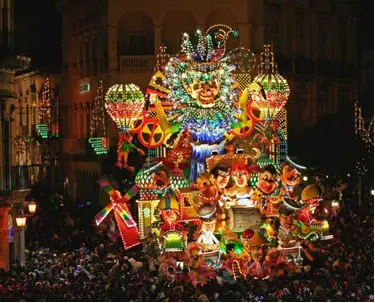
The carnival of Acireale has a long tradition that dates back to the 1500s. At that time it was a form of furious carnival with an overall participation of the people, and in which citizens drunk on wine, would go around the town with their faces painted, yelling, singing and duelling by throwing rotten eggs and citrus fruits at each other. In 1612, a notice of the Criminal Court “Jaci” (from sicilian dialect – Aci) categorically prohibited citizens of any class from throwing oranges and lemons during the period of “Carnelivari”( from sicilian dialect – Carnival) because of serious incidents occurred in previous years.
In the nineteenth century the carnival got a significant shift. In every street there were bizarre and funny popular games, such as the greasy pole, tug of war and sack race, and the nobles of the city paraded along the ways with their horse-drawn carriages while throwing confetti to viewers. But it was around 1880 that happened the first interesting turning-point in the history of the carnival in Acireale and this thanks to Sebastiano Longo who began working with paper-mâché with the intention of creating the first allegorical float – although the use of paper-mâché was widely used for the realization of sanctuary statues long before. From then on into the last century many groups of artisans entered into competition by creating their own float and allowing the Acireale Carnival to become a tourist attraction of authentic folklore likewise to carry the title of “the most beautiful Carnival in Sicily”.
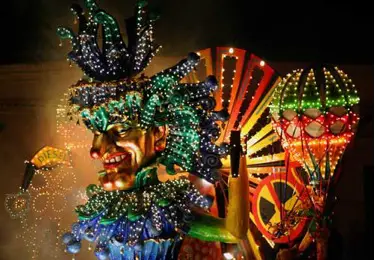
Even though the carnival is a fest that lasts nearly two weeks, that’s not the same as for the construction of the float whereas the artisans spend a whole year working. There are many accurate steps in creating floats and mainly paper-mâché masks and figures. First of all one needs to choose the idea of design and once that is chosen, the figure goes through the first phase which is the preparation of the clay. From the initial shape of the figure or mask, the artisan gradually builds the sections of the mouth, nose, eyes, etc. by using moulding instruments. In order to implement the mold one needs to use the plaster, which when properly mixed with water is smeared on clay for a thickness of about 8 to 10 centimeters. Once the plaster is well dry, the clay can be separated from the mold, until it is completely empty and clean, ready for the moulding of the paper-mâché. The next phase, which is the true working of paper-mâché, requires newspapers cut into rectangular strips. The first strips of paper will be applied to the mold with only water rather than glue to avoid them from sticking together. Unlike the first layer the successive layers will be applied using glue. Then there is a waiting period until the layers of paper will dry and at this point the paper fashioned in the mold will be removed. Removed from the mold the process moves on to plastering which consists in brushing the mask with liquid plaster. Once it is dried it is polished with sandpaper and ready to be painted utilizing water colors. The last step requires the paint so that the colors acquire brightness.
Below are some moments of the working process “AcirealeCarnival 2011”
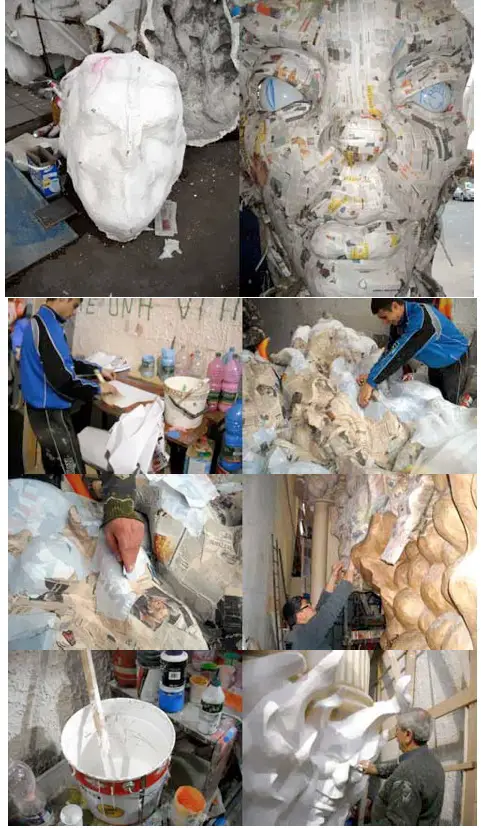
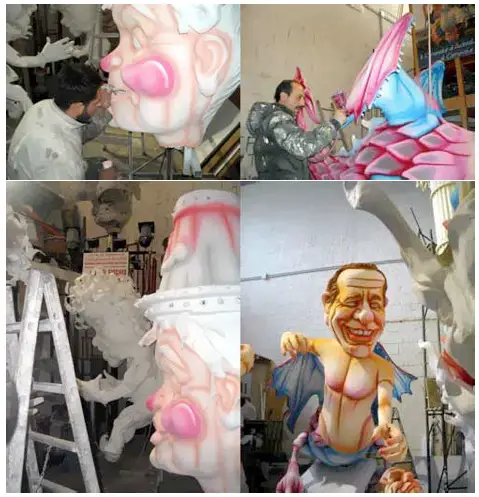
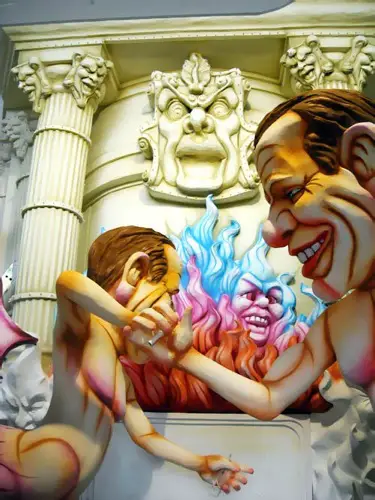
I recognize that through this short description of the Acireale Carnival I couldn’t pass to you the true cheerfulness this fest brings us, and I couldn’t describe the real effort that is behind the scenes being done to carry it out – but I hope I at least succeeded in increasing your curiousness for our traditions!
For more information visit: www.carnevaleacireale.com/en/
Writing by: “Rosario by www.EtnaMadre.it“
Credits:
Some photos by Roberta Pavone
Header photo by Luca Raciti
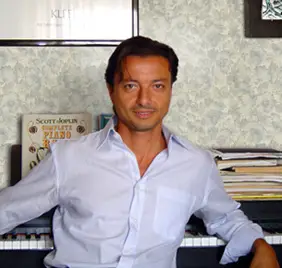 Rosario Scafaro is a guest contributor for Italia Living.
Rosario Scafaro is a guest contributor for Italia Living.
